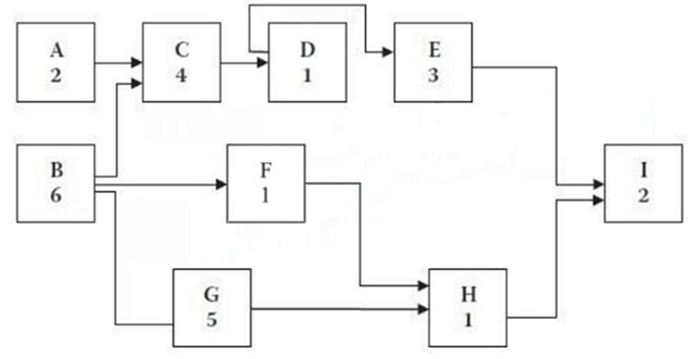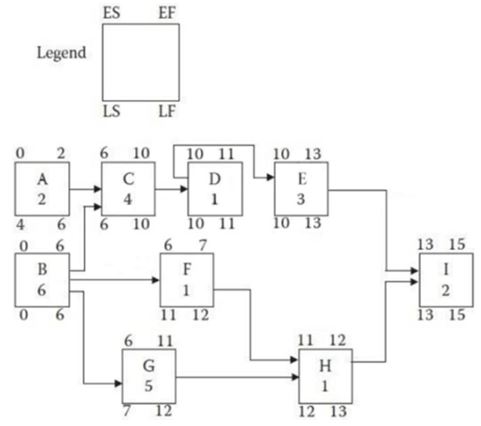PMI PMP-Project Management Professional Practice Exam Q. 201 to 210
Largest Questions Bank with All Unique Questions prepared by Project Management Experts as per the latest PMBOK
(Quickly Review Your Skills before appearing for PMI PMP Certification Exam)
Set of 10 Questions
Correct Answer has been Highlighted in RED
Q. 201: The risk management team of a software project has decided that due to the lack of adequate talent in the company, development of a specific part of the system is under high risk, so the team has decided to outsource it. This is an example of which risk response?
A. Transfer
B. Share
C. Avoid
D. Accept
Section: Initiation
<<<<<< =================== >>>>>>
Q. 202: What is the float for activity G?

A. -2
B. 0
C. 1
D. 4
Section: Mix Questions
Justification in favor of the correct answer:
Float = (late finish – early finish) or
(Late start – early start)
Activity G
LF = 12 (12 – 11) = (1)
EF = 11
LS = 7 (7 – 6) = (1)
ES = 6

<<<<<< =================== >>>>>>
Q. 203: What is the minimum a project schedule must include?
A. Variance analysis
B. A planned start date and a planned finish date for each schedule activity
C. A critical path diagram
D. Critical chain analysis
Section: Monitoring and Controlling
<<<<<< =================== >>>>>>
Q. 204: When sequencing project activities in the schedule, all the following are true EXCEPT:
A. There may be scheduled dates for specific milestones
B. Every activity is connected to at least one predecessor and at least one successor
C. Lead or lag time may be required
D. Necessary sequencing of events may be described by the activity attributes
Section: Mix Questions
Justification in favor of the correct answer:
The sequence activity process involves identifying and documenting relationships among the project activities. However, the last activity or milestone are not connected to at least one successor.
<<<<<< =================== >>>>>>
Q. 205: The ability to influence cost is greatest during which stages of the project?
A. Early
B. Middle
C. Late
D. Completion
Section: Initiation
<<<<<< =================== >>>>>>
Q. 206: During which process would you obtain stakeholders’ formal acceptance of the completed project scope?
A. Quality control
B. Scope verification
C. Scope control
D. Close project
Section: Closing
<<<<<< =================== >>>>>>
Q. 207: Which of the following is an example of a technique used in quantitative risk analysis?
A. Sensitivity analysis
B. Probability and impact matrix
C. Risk data quality assessment
D. Risk categorization
Section: Initiation
<<<<<< =================== >>>>>>
Q. 208: What is the primary benefit of meeting quality requirements?
A. Quality metrics
B. Less rework
C. Quality control measurements
D. Benchmarking
Section: Monitoring and Controlling
<<<<<< =================== >>>>>>
Q. 209: For any given project, the project manager, in collaboration with the project team, is responsible for:
A. Applying knowledge, skills, and processes uniformly.
B. Informing the project sponsor about which processes are going to be used.
C. Tailoring the processes to fit the abilities of the organization
D. Determining which particular processes are appropriate.
Section: Initiation
<<<<<< =================== >>>>>>
Q. 210: Prioritizing risks for further analysis or action by assessing and combining their probability of occurrence and impact takes place in which process?
A. Monitor and Control Risks
B. Plan Risk Management
C. Perform Qualitative Risk Analysis
D. Perform Quantitative Risk Analysis
Section: Initiation
Access the full Database of All Questions

An expert on R&D, Online Training and Publishing. He is M.Tech. (Honours) and is a part of the STG team since inception.
